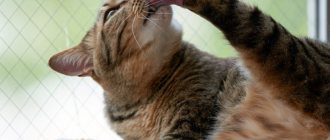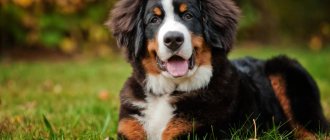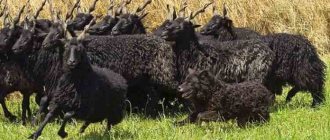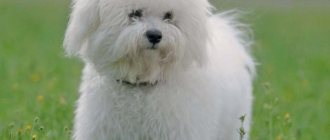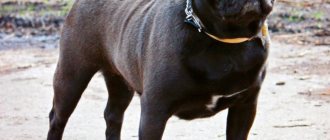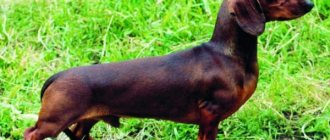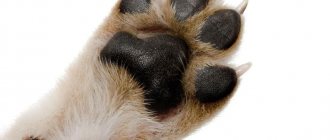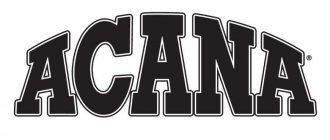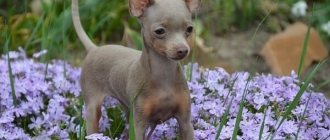- Facts about dogs
26411
Telegram
Currently, small dogs are very popular. They have a number of advantages compared to large dogs: they are less hassle, they do not take up much space and live quite comfortably in a small apartment, they are convenient and compact for travel, they do not have a pronounced odor, and even despite their small size, they They may well come to the defense of their owner.
Below, you can check out the top 15 most popular small dog breeds .
Chihuahua
Chihuahuas are also called pocket dogs for 2 reasons: firstly, they are the smallest of all dog breeds , and secondly, they love to be carried in the arms.
There are breeds with both long and short hair. There are different colors: black, red, white, chocolate, merle, brindle, etc.
1 of 7
The Chihuahua's height is 15-23 cm, weight from 0.5 to 3 kg.
The Chihuahua breed is active, playful, has pronounced guard traits, and feels quite confident next to an adult shepherd dog. She becomes very attached to her owner and remains devoted to him, does not tolerate long separation and loneliness. Chihuahuas are characterized by touchiness and jealousy.
It is not difficult to care for this breed; they are very simple in maintenance.
The lifespan of this breed is 11-14 years.
Chihuahua is the smallest breed in the world
Chihuahuas are the smallest dogs in the world. For them, the owner is the center of the Universe, so any separation from him is perceived as a tragedy. These are pets that prefer the company of humans to playing with their fellow tribesmen, so there will be no problems with calling them. At the first command, they joyfully rush to their owner, counting on hugs and praise.
These dogs are good companions for older people. But families with children are not recommended to have them until each child understands the fragility of these little creatures.
Russian toy terrier
The breed of decorative dogs is popular due to its cute face and miniature dimensions. The terrier's weight ranges from 1.4-3 kg, height - 20-28 cm.
There are smooth-haired and long-haired breeds.
1 of 6
The toy terrier is an excellent companion and watchdog, although it does not have aggression, but at the slightest rustle, it will demonstrate its loud bark, which is not so easy to calm down. He is also playful and restless, great for trips out of town and any activity in general. He has a good memory, he is intelligent and cunning, he notices the weaknesses of the owner.
Its lifespan is on average 10-12 years.
Pomeranian Spitz
The Pomeranian is a real plush toy, fluffy and with a cute face. He is very active, playful, attentive and easy to train. He loves walks in the fresh air. He is also a loyal friend and companion who loves his owner.
1 of 6
To keep his fur always beautiful, careful and regular care is necessary. The Spitz also requires active rest and long walks.
In terms of strength of character, the Spitz is in no way inferior to large dogs. He is characterized by guard qualities and a loud bark.
As for the dimensions, the weight of the Spitz ranges from 1.8 -3.2 kg, height - 18-22 cm. Life expectancy is 12-16 years.
Yorkshire Terrier
The Yorkshire Terrier gets along well with people and is a good companion. He is loyal, playful and brave. It is easy to train, but difficulties may arise due to its restlessness.
He is picky about food and has contraindications for many foods.
1 of 6
He is very playful, and during a walk, the Yorkie can bully other animals, despite his modest size. The Yorkie's height is 15-23 cm, weight - 2-3.2 kg. One of the advantages of the Yorkie is its versatility; it feels great both in a 1-room apartment and in a large house.
Great attention needs to be paid to caring for your Yorkie. Long-haired dogs need to be bathed every week, and short-haired dogs need to be bathed once every 2-3 weeks. Yorkies do not shed, but require daily brushing. Afraid of cold and dampness, because... he has no undercoat, as a result of which he quickly becomes hypothermic.
Why does hair loss occur?
A dog's eyes fall out due to exposure to certain factors. These include:
- ophthalmological pathologies complicated by muscle weakness and tissue distortion;
- mechanical injuries to the eyes, vertebrae in the neck or temporal bone;
- insect bites that cause an acute allergic reaction;
- stress, high temperatures and infections accompanied by pressure changes;
- active jumps on high surfaces;
- a tight-fitting collar, which increases the likelihood of injury when the leash is pulled sharply;
- prolonged constipation, forcing the animal to constantly push;
- grabbing by the scruff of the neck in adulthood (this action is only safe for puppies with light weight);
- neglect of hygiene.
Due to non-compliance with prevention, not only a pet at risk, but also a completely ordinary dog can suffer from proptosis. For this reason, all owners of four-legged pets need to know the main symptoms of a dangerous pathology.
Papillon
The Papillon or “butterfly dog” is a type of continental toy spaniel. This is a companion dog, very friendly, cheerful and active. The Papillon is distinguished by its energy and speed. At the same time, he can calmly sit in his arms if necessary, this is a very intelligent dog. The Papillon is also very touchy.
1 of 6
The disadvantages of the Papillon include shedding and special coat care. You need to bathe him once every 2 weeks, and you also need to regularly brush and moisturize the coat to avoid it drying out and forming tangles.
The breed has different colors: tricolor, white and sable, white and black, lemon, white and red, etc. Papillon weight is 1.5-5 kg, height is 20-28 cm. Life expectancy is 15-17 years.
A dog of this breed must have at least 2 puppies.
Japanese Chin
The Japanese Chin is a natural companion. These are sophisticated, very delicate and clean dogs. This breed is also sensitive and sentimental, and the Chin can become depressed if neglected. Showing love to members of its family, the chin needs reciprocity, and does not tolerate indifference and rudeness. Japanese Chins like to keep their owners in sight at all times.
1 of 6
This breed is calmer and more reserved compared to other decorative dogs. Chins are active and playful in moderation and require minimal physical activity.
The Japanese Chin has a silky long coat. Varieties of colors: spotted, white and black and sometimes white and brown. Their weight is 2-5 kg, height - 20-27 cm.
In general, these are cheerful creatures, intelligent, understanding and delicate, they get along well with other pets.
Miniature Poodle
The breed was bred in the 1840s in Switzerland and, according to the breeder, is “perfection itself ,” and the standard was approved in 1880. The dwarf poodle is a copy of the standard one , maintaining all proportions, they weigh 3-5 kg, and are up to 35 cm high at the withers. The toy poodle is smart, loves to learn and can become a real circus performer , entertaining family members with funny tricks. He is active, kind and cheerful, devoted to his owner, but without intrusiveness. Loves to bark loudly and spend time with children.
Maltese (Maltese)
The Maltese or Maltese has a high degree of intelligence and excellent memory, is very intelligent and intuitive, as if “catching thoughts.” At the genetic level, the Maltese has love and devotion to the owner, adapting to his type of temperament and character.
Maltese are sociable and loving dogs, they are very gentle with children.
1 of 6
You need to be careful with Maltese, they are very fragile.
One of the most common diseases is connective tissue dysplasia.
They do not need colossal physical activity, but leisurely walks in the air will not hurt them.
The dimensions of the Maltese are as follows: weight is 3-4 kg, height for a male is 21-25 cm, for a female - 20-23 cm. Life expectancy is on average 12-14 years.
Tibetan Spaniel
Looking at photos of dwarf dog breeds, you can also recognize the fairly common Tibetan spaniel with a light color and a dark muzzle. This is a calm dog in temperament that requires a moderate amount of attention. The average height is 25 cm with a weight of 4-6 kg. A puppy will cost 15-20 thousand rubles.
Pekingese
Pekingese are proud, moderately capricious and intellectually developed breeds. They are jealous and do not like to share their owner with anyone; they become very attached to him. But in general, this is a sociable dog that gets along well with all family members.
Pekingese weight is 4.5-5.5 kg, height is 18-23 cm, life expectancy is 12-15 years.
1 of 6
Excellent for indoor living, this is not a breed that needs long walks and physical activity. Pekingese can run and frolic, but only according to their mood.
Pekingese snores loudly and sneezes frequently, all due to brachycephaly (short muzzle)
The Pekingese's coat requires special care; it needs to be brushed and brushed more often to avoid tangles and to keep it overall looking beautiful.
Genetic diseases characteristic of this breed: cataracts, ectropion, respiratory disease, problems with the spine and musculoskeletal system, and heart failure.
Dwarf dachshund
The breed was finally formed in Germany at the end of the 19th century, thanks to the crossing of a standard dachshund and a miniature pinscher. The height of an adult is no more than 21 cm, and its weight is 4.5 kg.
dachshunds are born burrow hunters ; while walking, they constantly try to dig the ground in search of prey, and at home they hunt for smaller pets. She is active and willful, loves to spend time with children, but will not tolerate disparaging treatment and aggression . With a loud bark, the dachshund warns the owner about the guests and drives the stranger away from his territory. Possessing leadership qualities, it requires a strict and responsible owner .
Shih Tzu
The Shih Tzu is a very cute breed, with long beautiful hair, and it does not shed.
This is a companion and anti-stress dog. Gets along well with any animals and is very affectionate towards the owner. Can be fun and playful if the owner wants, but is generally a calm dog.
1 of 6
Shih Tzus are very easy to diaper train, which is convenient for owners who don't have time for frequent walks.
Shih Tzu weight according to the standard is 4-8.3 kg, height up to 27 cm. Colors are completely different, Shih Tzu come in almost all colors, and spotted (golden, white and red), black, black and tan, with masks, and with white faces, i.e. for every taste.
Genetically, this breed has no predisposition to diseases, but there are weak points: ears, eyes.
Life expectancy is 12-14 years.
Other breeds of small dogs with photos and approximate prices
There are other small breeds in the world that compete with the Chihuahua.
American toy
The Toy Fox Terrier appeared thanks to the popularity of traveling circuses touring the United States. Little artistic dogs entertained the audience by performing complex tricks and playing in skits with clowns. During breaks between performances, these passionate hunters exterminated rats that encroached on the troupe's provisions.
The weight of the Amertoy is from 1.5 to 3 kg, the height at the withers is no more than 20 cm. A distinctive feature of the Toy Fox Terrier is its large ears, making it look like a bat. Easy-to-maintain dogs are highly trainable and perform in competitions and performances. The cost of a puppy is from 20 to 45 thousand rubles.
English Toy (Manchester Terrier)
The Manchester Toy Terrier was bred in England to fight rats. This is an active, energetic dog, whose care is simple and easy. However, she needs a lot of physical activity and training. Otherwise, she may become wayward and disobedient.
With a height of up to 40 cm, the weight of the English Toy does not exceed 10 kg. The approximate cost of a puppy is from 20 to 24 thousand rubles.
Affenpinscher
Externally, the wire-haired Affenpinscher resembles a small monkey, as the name indicates. A strong, muscular build, short legs, dark bulging eyes and a flattened muzzle with a goatee are the hallmarks of this breed.
The Affenpinscher's character is temperamental and lively. With a lack of training and discipline, it becomes aggressive and can even bite its owner. It is recommended that such dogs be owned only by experienced people without small children. The height of an adult pet is up to 30 cm, weight is up to 6 kg. Sexual dimorphism is smoothed out. The cost of a puppy varies from 10 to 30 thousand rubles.
Belgian Griffon
The Belgian Griffon is a decorative dog with “human” eyes and a good-natured character. She gets along well with children and other pets, and quickly understands the routine in the house. In the loving hands of their owners, griffons reveal themselves as polite, intelligent companions, ready to share both grief and joy with a person.
Representatives of the breed love long, active walks, fun games and travel. The hard coat does not shed. Twice a year these dogs are trimmed to remove dead hair.
Griffon height is up to 20 cm, weight is up to 5 kg. Cost - from 20 to 40 thousand rubles.
"Toy Poodle"
The Toy Poodle is the smallest member of the Poodle family. This is a popular circus dog that is easy to train and evokes affection and admiration among the public. The pride of the breed is its fluffy, wavy coat, which gives the pet a doll-like appearance.
A prerequisite for quality care for your toy poodle is regular visits to the groomer's salon. There the dog is washed, combed and cut, giving the body a bizarre shape.
The height of a toy poodle is up to 28 cm, weight is up to 5 kg. The cost of a puppy is from 10 to 60 thousand rubles.
Italian and Maltese dogs
The Italian and Maltese dogs have common roots dating back to the Renaissance. These are small decorative dogs with a cheerful disposition and inexhaustible energy, which become strongly attached to their owners and have a hard time withstanding separation. They are calmer than other lap dogs, restrained in communicating with strangers and are not ready to put up with unceremonious treatment. Sometimes they have difficulties with socialization, so raising a lapdog needs to be done from puppyhood.
The thick, long coat of lapdogs does not shed and is odorless. To keep your dog in good shape, it is enough to brush it 3 times a week and, if necessary, bathe it using whitening shampoos. Exhibition animals require more complex, professional care.
The lapdog's height is up to 30 cm, weight is up to 4 kg. Price - from 15 to 40 thousand rubles.
Imperial Pekingese
The Pekingese is an ancient Chinese dog breed that, according to legend, originated from the union of a lion and a monkey. Pekingese are brachycephalic, that is, dogs with a short, flattened muzzle. As a result, they often experience breathing problems, have difficulty withstanding heat, and snore in their sleep.
Being a proud, independent animal, the Pekingese does not tolerate excessive tenderness and intrusive hugs. Therefore, it should not be purchased by families with children under 5 years of age.
The height of a representative of the breed is up to 25 cm, weight is up to 5.5 kg. Cost - from 10 to 25 thousand rubles.
Yorkshire Terrier
Like all terriers, Yorkies are tireless hunters. Previously they were used to catch rats, but now they are used as cheerful and energetic companions. Representatives of this breed are well suited for keeping in an apartment, but need long and interesting walks. A lack of impressions and training will turn a charming puppy into an indoor tyrant, attacking owners, passers-by and unfamiliar dogs.
Small terriers are overly talkative. They release emotional tension and stress through barking. Without timely correction, the habit becomes entrenched and becomes a problem for all family members. Another drawback is the tendency to dig holes, which is why the dog returns from a walk dirty, and the walking area looks like it was after a bombing.
Grooming is complex and painstaking. The dog needs to be washed, combed, and cut regularly, but the result exceeds all expectations. The height of the Yorkshire Terrier is up to 22 cm, weight is up to 3 kg. Price - from 25 to 80 thousand rubles.
Three varieties of bitter orange
Pomeranians belong to the indigenous group of breeds. Among them there are 3 types:
- Fox - with an elongated wedge-shaped muzzle, fluffy cheeks, a narrow chin, round eyes and a “button” nose.
- Bear - similar in appearance to chow chow puppies. Distinctive features: thick hair on the cheekbones, flattened muzzle, upturned nose, small ears.
- Toy type - obtained by Japanese breeders. It is an intermediate link between fox and bear Spitz, has a flat muzzle and high-set eyes.
The height of an adult orange is up to 20 cm, weight is up to 3.5 kg. Cost - from 30 to 90 thousand rubles.
Dwarf pug
The dwarf pug is similar to the standard one, but has smaller height and weight (up to 21 cm and 5 kg). The costs of breeding work have left a negative imprint on the health of these pets. Many mini-pugs suffer from diseases of the cardiovascular and respiratory systems, and they develop hip dysplasia.
These are cheerful and active dogs, but due to their anatomy it is difficult for them to withstand long walks. In addition, mini pugs do not tolerate heat well. Owners value them for their rich facial expressions, good-natured disposition and the tender affection that pets feel for all family members.
The cost of a dwarf pug varies from 35 to 50 thousand rubles.
Coton de Tulear
The Coton de Tulear is a miniature dog breed that was developed in Madagascar. These smart and friendly animals always want to be close to their owner, following him to the park and to the bathroom. The love of travel is written into the genetic code of these dogs, since their ancestors accompanied aristocratic ladies on long sea cruises. The long, cottony white coat makes the dog look like a toy. Thanks to its high intelligence, sociability and learning ability, the Coton becomes an excellent companion for adults and children.
With a height of up to 30 cm, weight is up to 5 kg. The purchase will cost from 40 to 50 thousand rubles.
Rabbit dachshund
The rabbit dachshund is the smallest hunting dog. A long body with short legs, a neat head and floppy ears are combined with a proud posture and high intelligence. Due to their small size and unpretentious maintenance, these brave and strong dogs were given the status of decorative dogs.
But without proper training and discipline, an energetic animal becomes uncontrollable and can show aggression towards people and other pets.
You can buy a dachshund for 15-30 thousand rubles.
German Keeshond
The Keeshond, or Wolfspitz, is the largest representative of the Spitz group. He inherited as much of the traits of his ancestors as barge dogs, which were used by sailors from Northern Europe to guard property and catch rats on barges. This is a native breed with wolf coloring, long fluffy hair, small triangular ears and a short pointed muzzle. The well-furred tail is curled into a ring and lies on the back.
This is a cheerful, loyal dog that can be both a companion and a watchman. They are also used in canistherapy: in hospices and clinics they relieve psychological stress and give patients positive emotions. The cost of a puppy is from 15 to 40 thousand rubles.
Toy Terrier bred in Russia
The Russian Toy is the smallest dog bred in Russia. Includes short-haired and long-haired types. Distinctive features of these animals: a round head with a convex forehead, a pronounced stop, a pointed muzzle, expressive eyes and large triangular ears with rounded tips.
These miniature, harmoniously built dogs are infinitely loyal to their owner, flexible and friendly. However, in case of danger, they rush to protect their family.
Cost - from 15 to 30 thousand rubles.
Ratlik (Prague rat)
Ratlik is a breed developed in the Czech Republic. Previously used to fight rats, but now it is a miniature fashionable companion dog. Ratlik loves to be the center of attention, is easy to train and demonstrates success in freestyle and agility competitions.
These graceful hustlers have an inexhaustible supply of energy and positivity. He turns even a walk in the park into an adventure, so the owner must pay attention to raising his pet.
It is difficult to buy a ratlik in Russia. For a purebred puppy you will have to pay from 25 to 40 thousand rubles.
Silky Terrier and Wirehaired Terrier
The ancestors of the Silky Terrier are the Wirehaired Terriers, from which the Yorkies and Australian Terriers were first bred, and then a new breed with a long, silky coat. Silks are sociable dogs that quickly become attached to their owners, get along well with children and get along with other animals. Since they have a well-developed hunting instinct, snares can attack mice, rats and other rodents. Intelligence and quick wit make these dogs good partners for training and sports.
Caring for snares involves weekly washing, frequent combing and periodic trimming by a groomer.
The price tag for snare puppies varies from 60 to 90 thousand rubles.
Papillon - eared
The Papillon is a small pocket dog with large ears that make it look like a butterfly. Hence the name of the breed. These are smart, quick-witted and active dogs that are easy to train. In 2015, a representative of this breed participated in the Russian OKD Championship. Papillons are patient with children and unobtrusive. But long hair requires careful care: washing, combing, and cutting should be done regularly.
Price - from 15 to 40 thousand rubles.
Fluffy Japanese Chin
The Japanese Chin is an ancient breed of dog that is mentioned in historical sources of the 3rd century. n. e. The first chinas were presented to the Japanese emperor, and this fact endowed them with privileges. There were many rumors surrounding the amazing appearance of the Chins, according to which the dogs originated from crossing with mythical creatures.
The long, luxurious coat of the Chin is devoid of dense undercoat, and the curled tail laid over the back creates the impression of a woolen fountain flowing to the ground.
Price - from 15 to 40 thousand rubles.
Havanese (Havanese Bichon)
Havanez is a national treasure of the Cuban people. A positive and always cheerful dog with a springy gait attracts the attention of passers-by. He is easy to learn, has rich facial expressions and is endowed with the makings of a circus performer. With a little training effort, the owner will receive a pet that will always cheer, comfort and keep company on walks and travels.
Price - from 25 to 45 thousand rubles.
Eskimo Spitz
The Eskimo Spitz, or American Eskimo dog, is a breed developed in the United States from German Spitz dogs. There are 3 types of these pets: toy (up to 28 cm tall), mini (up to 38 cm) and standard (up to 48 cm). Their decoration is fluffy wool of white, cream or light brown shade.
This is an intelligent, active dog, ready to protect the owner from danger, friendly to children, but does not tolerate familiarity and intrusiveness on their part.
Price - from 22 to 35 thousand rubles.
Bichon Frize (French lap dog)
A charming, obedient, sociable and very cheerful Bichon Frize breed. It looks like a dandelion (if you care for the coat properly).
The dimensions of the Bichon Frize are as follows: weight on average 5.5-6 kg, height according to the standard up to 30 cm.
1 of 6
489837_012The great advantage of this breed is its unobtrusiveness, i.e. if the owner does not have time to play with him, the bichon will not pester him, he does not need excessive attention.
Bichons are fearless towards both people and large dog breeds. They are trusting and loving, and will approach anyone with a good attitude. They love to go for walks and are ready literally 24 hours a day. If you are outside the city, you will practically not be able to drive it into the house. Clothes for walking are an optional attribute for a Bichon, even in cold weather. In addition, clothes are harmful to the wool. The coat requires special care: washing with shampoo and conditioner, drying with a powerful hairdryer and combing, but again, this is if you want your dog to be literally admired as if it were a white fluffy dandelion. It is necessary to wash and cut it once every 2 months, just bathe it once every 10 days.
Diseases that a French lap dog may have: luxation of the kneecap, cataracts, dysplasia.
Life expectancy is 12-15 years.
What to do if your dog's eye falls out?
If a dog's eye has fallen out, it must be taken to the veterinarian. Only 30 minutes are allotted for this, so there is a high probability that you will have to provide first aid yourself. To do this you need:
- Eliminate all extraneous factors that could worsen the animal’s condition. Place your pet in a comfortable position and try to calm him down. Remember that in the current situation you cannot panic. Your emotions will quickly be transferred to the victim.
- Prevent recurrent damage. Put a protective collar on your dog or supervise all his actions. Avoid any attempt to scratch.
- Treat the affected eye to remove dirt and secretions. Clean the mucous membrane with a lint-free cotton pad soaked in antiseptic. Then moisten it with saline solution and lubricate it with eye ointment. Avoid using harsh medications with alcohol and cotton wool. They can cause burns and new injuries due to the abundance of sharp fibers.
- Reduce swelling. Apply ice wrapped in thick cloth to the affected area: 10 minutes will be enough, since too much exposure to cold can result in tissue hypothermia.
Please note that self-reduction is not permitted. This can only be done under general anesthesia, so avoid feeding until you see your veterinarian.
First alarming symptoms
If you have never encountered proptosis in practice, be sure to familiarize yourself with its symptoms. It includes the following features:
- photophobia (the pet constantly squints and hides in dark corners);
- dry cornea;
- pinching of the eyeball by the eyelid;
- profuse lacrimation (there may be traces of blood in the discharge);
- swelling of the conjunctiva and adjacent tissues;
- frequent blinking and scratching of the disturbing area;
- anxiety and depression, accompanied by periodic whining due to pain or other unpleasant sensations.
The victim should be taken to a veterinary clinic within 24 hours. After this time, the likelihood of complications increases, worsening the prognosis for recovery even after surgery.
The most common consequences of proptosis include the following:
- strabismus;
- cataract and glaucoma;
- loss of visual acuity;
- degenerative changes within the retina or its detachment;
- optic nerve atrophy;
- keratitis, uveitis and conjunctivitis;
- corneal ulcer;
- increased pressure inside the eyeballs.
The worst case scenario is blindness. Its appearance is characteristic of complete atrophy of the tissue inside the damaged eye. The only treatment for this complication is organ excision.
Contacting a veterinarian and treatment
During the examination, the veterinarian should examine the damaged eyeballs and check the integrity of the nerves. Based on what he saw, he can offer 2 options for surgical treatment: reduction or removal. In both cases, the intervention is performed under general anesthesia using anesthetics and painkillers.
Surgical intervention for reduction includes the following steps:
- Cleansing the eye of accumulated exudate, tear fluid and dirt.
- Trimming or dissecting the outer corner of the eye (external commissure of the eyelids) with a scalpel, followed by administration of drugs behind the eyeball.
- Direct reduction of the prolapsed organ with a napkin treated with tetracycline ointment.
- Applying a special bandage, lubricated with antimicrobial ointment, and sutures to the operated eyelids.
The rehabilitation period takes 15-30 days. 10 days after the operation, the bandage is replaced with a new one, re-treated with antiseptics and antibiotics.
Please note that removing sutures without the approval and involvement of a veterinarian is prohibited. This can lead to complications:
- granulating ulcer;
- cataracts;
- neuritis or optic nerve pigmentation.
For the safety of your pet, monitor the condition of his eyelids. If swelling, bleeding or purulent discharge occurs, be sure to seek help without waiting for your scheduled appointment.
Cavalier King Charles Spaniel
This is an exquisite breed with beautiful long hair. The most common cavalier colors are: tricolor, ruby, black and tan, and Blenheim. Weight on average 6-8 kg, height 25-27 kg. Life expectancy is 9-14 years.
1 of 6
Cavalier King Charles Spaniel tricolor Tochter von Dominic vom-Residenz-Garten Deckrüde
The King Charles Spaniel breed is playful, playful, friendly, and gets along well with other pets. He has excellent intelligence and understands when it’s time to stop frolicking. Also, the gentleman perfectly senses the emotional state of his teacher and follows his instructions.
Cavaliers are unpretentious in their maintenance and can live both in a small apartment and in a large country house.
The Cavalier King Charles Spaniel breed needs daily exercise.
This breed has a predisposition to a number of diseases: heart disease, endocarditis, allergies, diabetes mellitus, inflammation of the paraanal glands.
Less popular breeds
There are other small breeds of dogs for apartments.
Andalusian Pied Piper
The Andalusian Pied Piper is an energetic dog with strong hunting instincts. The agile pet cannot sit still, he needs active physical activity, classes with a dog handler and games with the owner.
If such a dog becomes bored, it may develop destructive behavior: it will chew furniture, wires, hunt other pets, or start fights with its fellow tribesmen. Price - from 200 to 500 euros.
Basenji (for experienced breeders)
The Basenji is an African non-barking dog. Features of the breed are a purr instead of a bark, folds on the forehead, a tightly curled tail and a lack of odor. Many Basenjis can, like cats, wash themselves with their paws.
These are dogs with strong immunity and fearless character. They are confident, assertive and smart. Without proper training and discipline in the hands of an inexperienced owner, they can become aggressive and disobedient. For the happiness of being the owner of a Basenji, breeders ask from 20 to 50 thousand rubles.
Bichon Frize
The Bichon Frize is a hypoallergenic breed of French origin. This is a good companion and family dog with a sharp mind, energy, a positive attitude towards children and good health. Representatives of this breed often become long-lived, delighting owners for 18-20 years.
White curly hair makes Bichons look like toys, but only with quality care. The owners of these plush pets are regulars at grooming salons. Price - from 20 to 75 thousand rubles.
Border Terrier
The Border Terrier is a small, wire-haired dog that was formerly used for hunting foxes. Distinctive features of the breed: sociability, activity, intelligence. Border Terriers require close human contact. If the owner does not have enough time for walks and games, the energy of these dogs results in destructive behavior.
Overly active dogs can injure a child when playing. To avoid this, the pet must be taught discipline and provided with long-term exercise.
Height - up to 41 cm, weight - up to 7 kg. Cost - from 30 to 37 thousand rubles.
Valencian rater
The Valencian rater is a breed close to the Andalusian ratcatchers. The graceful, muscular dog is still used to catch rabbits. Because of this, she has a well-expressed hunting instinct, which not every owner can cope with. If you neglect education and training, the rat catcher catches and kills all animals smaller than himself: cats, chickens, guinea pigs, hamsters. Conflicts with other dogs on the street will be frequent.
In addition, this breed is characterized by distrust, aggressiveness, and independence. It is not easy to make a companion out of it, but the breed is well suited for hunting and outdoor activities.
Height up to 40 cm, weight up to 7 cm. Price - from 50 to 75 thousand rubles.
West Highland White Terrier
The West Highland White Terrier is a lively and sociable dog that requires a firm hand when training. Representatives of the breed are smart, stubborn, and independent. As they grow older, they become more self-confident, so they need to be trained from puppyhood.
The stocky West Highland White Terrier is covered with short, coarse hair that helps it get through bushes and protects it from dirt, cold and rain. His height is up to 28 cm, weight is up to 9 kg. Cost - from 25 to 45 thousand rubles.
Griffon Brussels
The Brussels Griffon is a relative of the Belgian. This small decorative dog feels good in an apartment and does not need daily brushing. She is sweet and good-natured, but with the connivance of her owner she can become cocky and arrogant. Brussels residents need close human contact, so you can take them with you on trips.
They perceive children as playmates, so they can have fun running around the lawn with them, but they will not tolerate rude or cruel treatment.
Height - up to 20 cm, weight - up to 6 kg. Price - from 30,000 to 70,000 rubles.
Jack Russell
The Jack Russell Terrier is a compact, active dog with boundless energy. He needs long walks with fun games and running around. High learning ability, sociability and desire to work make the Jack Russell a good partner for training and canine sports.
Tireless adventure seekers, these dogs love to travel with their owners. They can handle car trips and air flights without any problems, and they behave calmly on the train.
Height - up to 30 cm, weight - up to 6 kg. Price - from 15,000 to 40,000 rubles.
Small spaniels
There are two types of decorative spaniels: the King Charles Spaniel and the Cavalier King Charles Spaniel. Both breeds make good companions and family dogs. But they can be touchy and jealous. They do not tolerate heat well.
Like all long-haired dogs, they need frequent brushing and washing with an anti-tangle balm.
Prices for small spaniels range from 40,000 to 60,000 rubles.
Miniature boule
The Mini Bull is a miniature version of the standard Bull Terrier. Stubborn and independent, needs training and a firm hand. With an inexperienced owner, it quickly turns into a tyrant.
The minibull is distinguished by a harmonious physique, well-developed muscles, and an ovoid head shape. The coat is short, lying close to the body. The cost of a miniature bull terrier is from 35,000 to 50,000 rubles.
Golden York
The Goldust Yorkie is a rare and expensive breed of dog. These are cheerful, cheerful and active pets who never tire of delighting their owners with endless games, pranks and pranks. If the owner does not neglect the communication, upbringing and training of the puppy, he will grow into a dog with whom you can go for exercise, to an exhibition, and on a trip.
The Goldust Yorkie does not tolerate loneliness well. If your work schedule does not allow you to spend a lot of time with your dog, you can get a couple of pets. In such a company they will definitely not be bored. Golden Yorkies from breeders cost from 50,000 to 80,000 rubles.
Chinese Crested Dog
Chinese Crested dogs can be downy or hairless with veil-like hair on the head and tip of the tail. These are small, graceful and cheerful pets who are devoted to their family. They have strong immunity and rarely suffer from infectious diseases. However, from an early age they can suffer from dental problems and are easily injured when jumping.
Corydalis lend themselves well to trick training. Cost - from 12,000 to 25,000 rubles.
Corgi
The Corgi is a brave shepherd dog trapped in a small body. A representative of this breed is easily recognized by its strong body, short legs and tail, and large, high-set ears with rounded tips. These fidgets love long walks and are ready to play with their owner for hours. There are 2 types of these dogs: Pembroke and Cardigan.
A corgi puppy costs from 35,000 to 80,000 rubles.
Lhasa apso
The Lhasa Apso is one of the oldest dog breeds on Earth, with roots in the monasteries of Tibet. These are cheerful, assertive dogs, distrustful of strangers. Their decoration is long flowing hair that covers the eyes and forms a beard and mustache.
Despite its toy appearance, in case of danger the apso will rush to the defense of its owner without hesitation. The cost of a Lhasa Apso is from 25,000 to 35,000 rubles.
Florentine Spitz
The Florentine Spitz (Volpino Italiano) is a fluffy lap dog whose playfulness, good nature and optimism have gained popularity among families with children, the elderly and those who travel a lot around the world. Being an excellent companion, she can also perform the functions of a watchman, announcing the approach of strangers with a ringing bark.
Like all Spitz, Volpino Italiano are well trained and quickly understand the routine in the house. The cost of a dog is from 15,000 to 25,000 rubles.
miniature pinscher
The Miniature Pinscher is a smaller version of the Doberman Pinscher, just as bold and courageous as its larger counterpart. Looking at photos of these animals, some do not suspect that in their compact body lies the spirit of a service dog, which, if necessary, will give its life for its owner. An aristocratic appearance, developed muscles, a chiseled wedge-shaped head and free, dynamic movements with beautiful gaits are the distinctive features of the miniature dog.
A dwarf Doberman costs from 20,000 to 35,000 rubles.
Schipperke herding dog
The Schipperke is a small herding dog with a light, cheerful character and elegant appearance. Can be kept both in an apartment and in a house with its own local area. Such a pet will become an “alarm bell” that rings every time a stranger approaches the door. While protecting the owner and his property, she can bite the attacker.
Grooming is simple and consists of regular brushing and washing no more than once a month. Schipperkes need a long and active walk with games, activities and a lot of impressions.
Future owners will pay from 25,000 to 50,000 rubles for a Schipperke.
Petit Brabançon
Griffon of Belgian origin. This breed is also called Petit Brabançon, Brabant Griffon and Smooth Griffon. Brabant Griffons are relatively small in size compared to other decorative breeds. Their weight is from 4 to 6 kg, height is 18-20 cm.
1 of 5
The Brabançon is a companion dog, very affectionate and friendly. She is characterized by courage, self-confidence, liveliness and the need for communication. This breed is active and loves to play and requires daily walks. Brabançons are sensitive, feel the mood of their owner and experience emotions with him, repeat all his actions.
No special care is required for their coat, as they have short, slightly spiky fur. You only need to brush it once a week.
Their great advantage is that they do not have genetic diseases, and they practically do not suffer from colds.
The lifespan of a Brabançon is from 8 to 14 years.
Pros and cons of small dogs
Even though these dogs are quite small, you need to be prepared for anything.
Advantages
It is quite natural that a small dog, compared to a large dog, will eat much less food in the same period of time, so having a small dog in the house can save significant money. In addition, a small dog does not need much living space. After walks, and in the process of life, a small dog produces a minimum of hair, dust and dirt.
When going shopping at the store or going out of town to the country, as well as in other cases, such a pet can be placed in a handbag, where this four-legged friend feels very comfortable. If you raise such a companion correctly, then he will be friends with other pets, with small children, and they are not so aggressive towards strangers.
Important point! Small dogs relieve themselves without any problems on a tray that can be installed on a loggia or balcony. This is very convenient, since the owner has more free time and does not need to think about systematic walks, both during the day and in the evening.
An important factor is life expectancy. With proper care, decorative dogs can live about 2 decades, although similar longevity records are also typical for medium-sized dog breeds.
Flaws
Many indoor dog breeds are serious pets that require training and education. Unfortunately, many owners of decorative dogs do not realize this. The same can be said about small hunting dogs, whose behavior is not so flexible. Some breeds of small dogs have increased activity and excitability, which must be directed in the right direction through training. Increased excitability against the background of high muscle activity leads to noticeable energy expenditure, which must be compensated through diet.
Interesting to know! The digestion process of small dogs is more energy-consuming, since they have a larger gastrointestinal tract compared to their total body weight. Therefore, their diet should be more balanced and higher in calories.
The difficulty of feeding such pets also lies in the fact that they quickly get used to one type of food, which is sometimes quite harmful. If you start feeding an animal with sausage or chicken legs, it is unlikely that the dog will be able to switch to feeding other food, unless under the threat of starvation. Owners of such animals will have to face a number of other behavioral problems. These animals follow their owners or other family members literally on their heels. Due to this fact, many of them fall under the feet of their household members, receiving injuries of varying severity.
Some small artificially bred dog breeds are susceptible to various congenital pathologies that are associated with:
- Dislocation of the kneecaps.
- Necrosis of the femoral head.
- Not overgrown fontanel.
- Absence of teeth or presence of 2 rows of teeth. Predisposition to tartar.
- Various allergic reactions.
Dogs that are trained to use a litter tray begin to mark corners as they age if they are not walked for a long time. A sharp and unpleasant odor also appears. This problem can be solved through castration, but the most humane and effective method is considered to be regular walking of your pet.
Top 10 most popular small dogs\Top 10 most popular small dogs
Chinese Crested
There are two varieties: naked and downy. In this article we will talk about the hairless Chinese Crested.
They come in completely different colors. The dimensions of the crested one are as follows: weight from 2.3 to 5.5 kg, height in the range of 23-33 cm.
1 of 6
These are very comfortable dogs to live in; they adapt well to their owners. They will play with him if necessary, and when the owner goes to sleep, they will calm down. Hairless, crested, unobtrusive breed.
He loves children very much and is easy to teach and train.
The crested cat needs to be bathed once a week. The use of scrubs and masks is encouraged. It is also necessary to epilate it and use sunscreen in the sun.
The breed has an allergic reaction to the sun. There is also irritation from hair removal and clothing.
For clothing, to avoid irritation, it is recommended to use silk seamless overalls. In general, this breed is cold-resistant.
The Chinese Crested cat practically does not get sick; the only hereditary disease that occurs is eye disease.
Life expectancy is 12-14 years.
Pug
One of the most popular dog breeds.
The weight of a pug is on average 6-8 kg, height 28-32 cm.
1 of 6
Pugs are loyal and affectionate. They love their owner immensely and become very attached to family members. Often follows the owner everywhere in the apartment. They are also very friendly and ready to greet guests playfully. They get along well with other animals and love children.
Pugs are quite amenable to training, despite the fact that they are not very active. They do not need long walks.
The breed also exhibits a high degree of intelligence and good protective qualities. It is well suited for beginners, because... its maintenance is minimal.
Prone to overeating and obesity, so they require a strictly balanced diet
Pugs are prone to certain genetic diseases and allergies. Their life expectancy is 13-14 years.
How to choose a dog
Helpful tips for choosing a pocket dog:
- Decide on a specific breed. In this case, it is necessary to take into account not only appearance, but also character. Difficulties in grooming (length and structure of coat, etc.) are important.
- Choose a good nursery or a reliable, trusted breeder that has many positive reviews.
- Do not try to buy the tiniest dog possible, since dwarfism is always associated with major health problems.
- Do not buy an animal from an advertisement or from someone else, as there is a high probability of buying a counterfeit animal. Unscrupulous breeders often overestimate the age of puppies, claiming that they will be miniature. This way you can buy an ordinary medium-sized dog or, even worse, a known sick animal.
- Be sure to look at the parents, their living conditions and documents (pedigree, exhibition diplomas, etc.).
- Decide on the purpose of purchasing a pet (just for the soul, for breeding, for exhibition activities).

